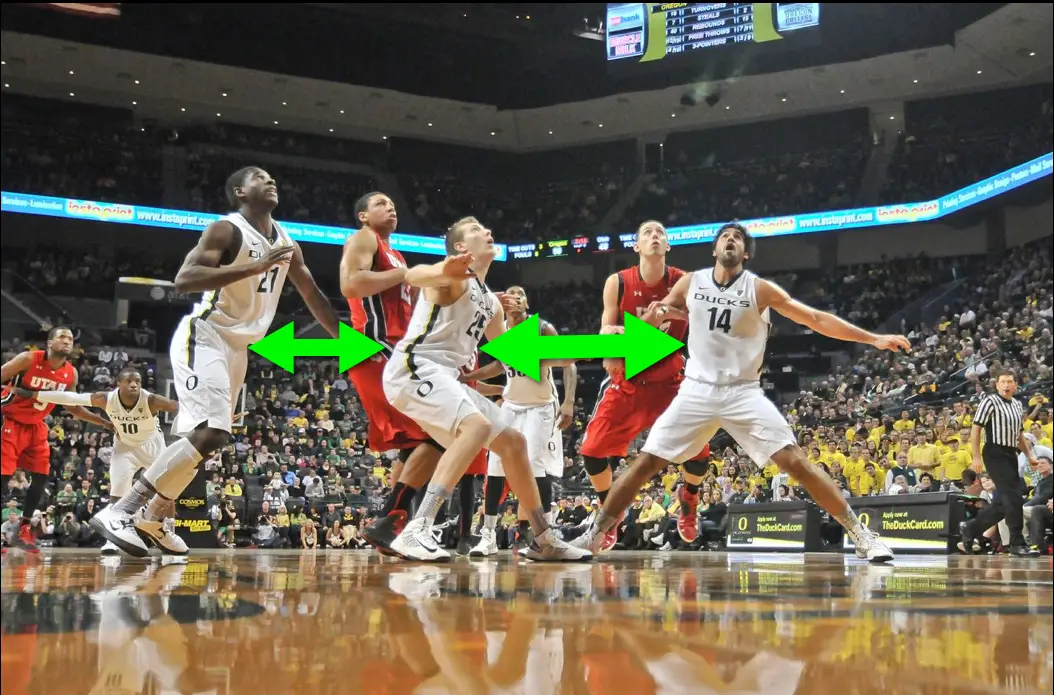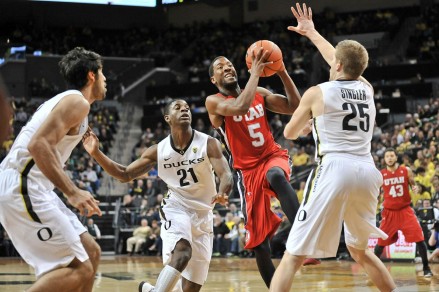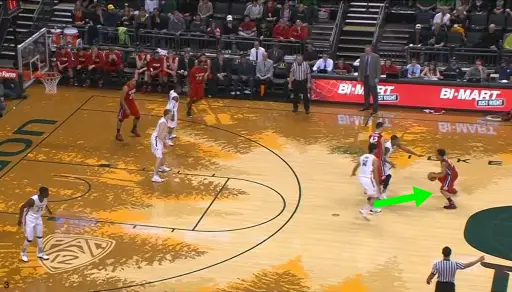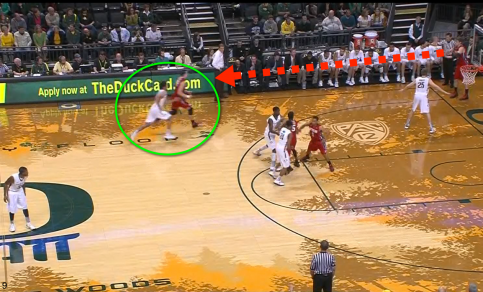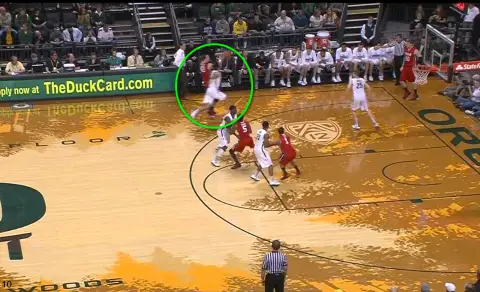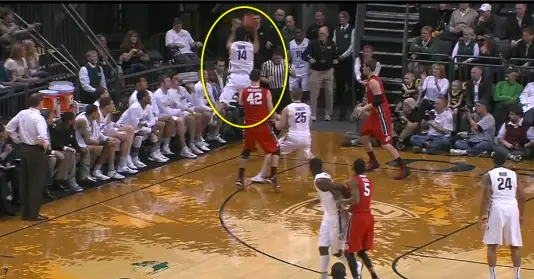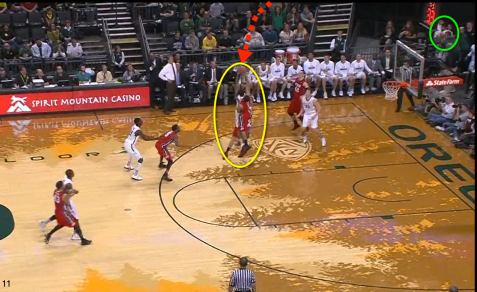Arsalan Kazemi, Oregon’s most popular Iranian, has been a vital cog in the improved defense of this year’s No. 23 Oregon team. When the Ducks rallied to beat Utah last week, ending a three-game slide and regaining a share of the Pac-12 lead, much was reported about the normally-reserved Kazemi and his emotional statements to the team at halftime — which inspired a rousing turnaround and sorely-needed Duck victory. According to his coach, it was the best half of basketball for Kazemi as a Duck.
Most people that follow Oregon know that Kazemi is an unusually adept rebounder, but probably not many know just how good he is statistically. Including his three seasons at Rice before transferring to Oregon, Kazemi has pulled down 1,175 career rebounds. For comparison, Greg Ballard holds the Oregon record with 1,114 (1973-77). However, Kazemi’s rebounding prowess is a story for another day. I want to analyze just how great of an impact he has on other parts of the defensive success Oregon has had this season. It only takes film from parts of the second half of the Utah game to find three such plays.
In the Utah contest, Kazemi recorded his 51st career double-double, his sixth this season. But in addition to his 11 points and 14 rebounds, he also had four steals, three blocks, and many other hustle plays that helped spark the Duck comeback. His energy, toughness, and uncanny ability to anticipate and turn steals into Oregon fast breaks, makes him a favorite with the Pit Crew and his growing Duck following.
The first sequence: Blocked Shot. The play I want to illustrate comes early in the second half with the Ducks still trailing. It depicts a tremendous blocked shot by Kazemi, who recognizes a teammate in trouble and comes to help. The rejection revved up the crowd to a louder level that anytime in the first half. 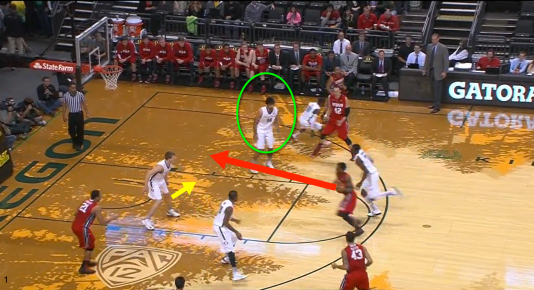 (Above) Utah’s Jarred DuBois (red arrow), drives past Damyean Dotson as he attacks the hoop, while E.J. Singler moves into position to take a charge (yellow arrow). Kazemi (green circle), prepares to rotate and help.
(Above) Utah’s Jarred DuBois (red arrow), drives past Damyean Dotson as he attacks the hoop, while E.J. Singler moves into position to take a charge (yellow arrow). Kazemi (green circle), prepares to rotate and help.
(Above, from a different camera angle behind the basket). As Dotson (21), trails the play, DuBois (5), successfully avoids a collision with Singler (25), who is also helping off his man, trying to take a charge on the shot attempt. Kazemi coils his spring-like legs and prepares to leap.
(Above) Kazemi (green circle), uses his hops to reject DuBois’s layup and send the ball the other way to Carlos Emory (33), who waits to release on the break.
 (Above, from the baseline camera angle). The perfectly-timed block from Kazemi gets the Ducks going in transition, and the comeback is on.
(Above, from the baseline camera angle). The perfectly-timed block from Kazemi gets the Ducks going in transition, and the comeback is on.
Another example of Kazemi’s defensive basketball savvy is how well he helps defend the high Pick and Roll, a basic offensive play that most basketball teams utilize on a regular basis, from junior high to the NBA. Against Utah, Coach Dana Altman went with a small lineup for nearly the entire second half, which meant that Kazemi was the Duck “big man” for the duration of the game. This proved to be an advantage for the Ducks defensively, as Kazemi utilized his quick feet and was able to defend the Utah guards out on top, far from the hoop at times.
The Pick and Roll, which occurs typically when an offensive post player screens the point guard’s defender at the top of the key, trying to free the guard to attack the basket, shoot, or feed the post. The goal for the offensive post is to screen the guard’s defender, and then roll to the basket, creating a size mismatch if the defenders switch defensive assignments.
The play can be defended several ways. Altman likes to defend the play very aggressively, and rush the big man out to hedge, or jump at the ball handler who has been screened. The object of the aggressive defensive play is to slow the point guard, and push him away from the basket so he has to start the offense much farther out than desired. Often, the Ducks will double-team and trap the guard. Point guard Jonathan Loyd, pressed into full-time duty in place of injured Dominic Artis, explains Oregon’s philosophy: “We’re taught if the big man can get up there, it’s a hard hedge. The guard [defender] goes underneath to control the dribbler while the big man gets back.”
The second sequence: Defending the Pick and Roll. This play illustrates how aggressively Oregon defends this basic offensive set, and how Kazemi brings a whole new dimension to this defense. The Ducks did not get a steal on this particular play, but with Kazemi harassing the ball handler, it delayed Utah getting into its offense and forced a shot-clock violation when Utah’s Brandon Taylor threw up an airball with one second on the clock, resulting in a turnover on the play and another possession for Oregon.
(Above) Kazemi (14 green arrow), anticipates giving help to Emory (other white uniform out top), with Taylor, who has the ball.
(Above) Kazemi shoots out (green arrow) to harass Taylor, pushing him to dribble well outside his comfort zone in starting the offense, and the shot clock is ticking down. Of Kazemi’s clever ability to hedge screens, Singler said, “He makes a lot of plays hedging the ball out there. He gets a lot of steals from it.”
(Above) At this point, Kazemi nearly steals the ball from behind Taylor (yellow circle), tipping the ball toward half court and further from any semblance of Utah offensive execution. The clock continues to tick down. Loyd said, “Arsalan’s real, real good at hedging. He really shoots out there and has real quick hands. If the guard’s not careful, it’s going the other way.”
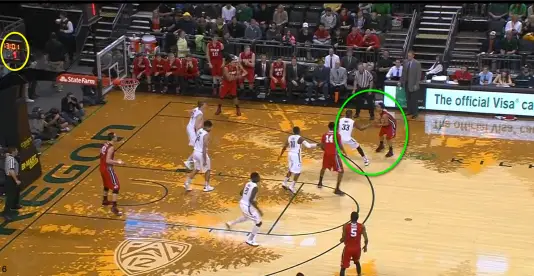 (Above) Note the shot clock in the upper-left corner of the photograph (yellow circle). Utah’s Taylor has the ball in his hands with one second on the clock with Emory in his face (green circle). He throws up a hurried air ball that returns the ball back to Oregon for another possession. Even though Kazemi didn’t actually cause a steal, his efforts helped Utah have a poor possession at an important point in Oregon’s comeback.
(Above) Note the shot clock in the upper-left corner of the photograph (yellow circle). Utah’s Taylor has the ball in his hands with one second on the clock with Emory in his face (green circle). He throws up a hurried air ball that returns the ball back to Oregon for another possession. Even though Kazemi didn’t actually cause a steal, his efforts helped Utah have a poor possession at an important point in Oregon’s comeback.
Altman said, “He’s the best I’ve ever had at getting out there and moving his feet. He anticipates really well, and hedges those picks as well as anybody I’ve ever coached.” That’s effusive praise from someone who has coached at the Division I level for as long as Altman. He continued, “His skills on the glass [rebounding] and his basketball savvy around the basket is as good as anybody I’ve ever had.”
The third and final sequence: The Steal. In this amazing play midway through the second half after Oregon had clawed their way back to lead 44-43, the Ducks set up their full court man-to-man press after a Utah turnover. Momentum was on Oregon’s side. The crowd was finally into the game because of Oregon’s defensive effort, their hustle, and determination. All were exemplified by Kazemi and Willie Moore on this play.
(Above) As Utah’s Jason Washburn (42), breaks to receive the inbound pass (red arrow), Kazemi breaks with him.
(Above) Kazemi (green circle), tips the ball ahead toward the baseline and flies after it.
(Above) He sprints after the ball and flips it back high, high over his head in a desperate attempt to hold possession. His momentum takes him into the corner. Notice Moore (24), watching the play unfold. He makes a huge athletic play to come down with Kazemi’s sensational save and allows Kazemi to record one of his four steals on the day.
(Above) Moore leaps high to grab the Hail-Kazemi pass. (Moore is sandwiched between two Utes in the yellow circle). The Ducks didn’t score directly after the steal, but the Ducks gained the possession and got another offensive rebound before finally scoring to lead 46-43. Check out the upper right hand corner. It’s Kazemi! (green circle)
His rebounding skills and willingness to do the little things defensively, set Kazemi apart. Oregon is fortunate to have him and his coaches, teammates, and fast-growing fan base, know it. Altman smiled when he said, “Now, he needs to front the post a little bit better–I keep yelling at him about that, and he could be more aggressive offensively. But the things he’s good at, he’s very, very good.”
Related Articles:
Luke Roth (Basketball Analyst) is a retired teacher and coach who has lived in Eugene since 1977. He coached high school basketball for 34 years, including 26 years as Sheldon HS girls varsity basketball coach (1984-2010). Luke taught at Sheldon for 30 years, and in the International HS at South and Sheldon, for 20 years. He taught journalism and advised the school newspaper at Sheldon during his stint there. He is a long-time Duck fan and UO alum (MA 1985). Luke has been married to his wife Catherine for 36 years with two grown children and one eight-year-old grandson. In retirement, Luke spends his time hiking, biking, gardening, writing, and playing the stand-up bass in the Sorrel Way Jam. Follow Luke on Twitter: @luke_lukeroth

